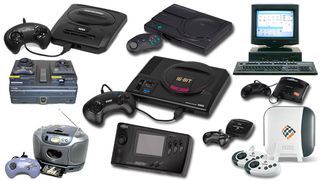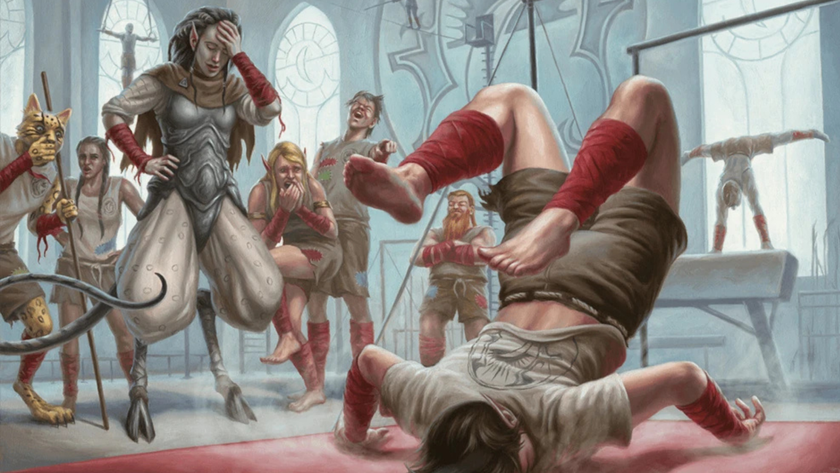The history of console redesigns
Same again, thanks, but smaller
Console do-overs through the ages

Nintendo's newly unveiled Wii Mini might have provided momentary distraction from the company's touch screen-toting big-ticket release, but the downsized budget-console hardly came as a surprise. After all, the one-size-only GameCube was the exception to a long-standing rule--one established in the early days of console gaming, and followed by every major player since.
Whether it's improved performance, a space-saving refit, or lower prices, almost every major console has seen its lifespan enriched via redesign. Here's a look back at some of the machines that managed to win another season of our fickle favor, simply by dropping an SKU size or two...
NES

We're hardly blowing your little world apart by pointing out that the NES of all our Western childhoods (center) was itself a redesign. Nintendo's Famicom (lower left), or Family Computer, had been chugging along in Japan for a couple of years before someone in 1985 pointed out that Western children also have thumbs, imaginations, and couches--and hence might also enjoy playing some Nintendo. One industrial-chic grey redesign later and everyone had an NES, unless you were 8 years behind the curve and got an NES-101 (top right).
Additionally, the console saw no end of unauthorized international redesigns, though collaborations with the Sharp corporation resulted in some officially sanctioned Japan-only reissues. The Twin Famicom (lower center) added a Famicom Disk drive to an externally remodeled Famicom, while the Famicom Titler (lower left) had a touch screen, keyboard, and rudimentary programming capabilities. Least revolutionary was the C1 NES TV (top left), but being as it was also the most obvious idea--a TV with an NES in it!--it was also the only one to make it to America.
Genesis/Megadrive

Sega's 16-bit workhorse (center) scarcely had time to make its introductions in the West before the company was pushing the Genesis 2 (top left), whose reduced cost and footprint came alongside streamlined connection capabilities (a nice way of saying it had less output options). Even more spartan were the later Genesis 3 (lower right) and battery-guzzling portable Nomad (lower center).
Sega attempted to expand the Genesis' range via PC/console hybrids such as the IBM-produced TeraDrive (top right), alongside music-and-gaming combos like the portable Aiwa Sega CD (lower left) and Pioneer's console/LaserDisc combo, the LaserActive (center left). JVC's X'eye (top) bundled together a Genesis, Sega-CD, and bewildering sound-creation peripherals, while ATGames' Firecore (far right) stripped the console so far back it wouldn't even play music properly. Lastly, TecToy's Mega Drive 4 (lower right) launched in Sega-mad Brazil in 2009, and the SD card-based next-gen Genesis was too cool even for a cartridge slot.
SNES

Just like with the Famicom, Nintendo redesigned its Super Famicom (center) for the US market--though while American players got the boxy purple-toned SNES (top right), European and PAL gamers shared the distinctive lines and colors of the Japanese original. Those disparate designs came closer together with the release of the SNES 2 (lower right) and Super Famicom Jr (lower left), all but identical save for the purple/multicolor button layouts.
As it had done with the NES, Sharp put together a special TV for the occasion, the SF-1 SNES TV (top left)--appropriately named because any world in which you can get a TV with a SNES inside it is obviously some sort of futuristic Sci-Fi wonderland. Perhaps more versions would have appeared had it not been for that business with Sony and the CD drive that never was; but that would take all day to explain, so we should move on to...
PlayStation

Because the Sony PlayStation was such a triumph of branding and a game-changing repositioning of the relationship between video games and traditional media, Sony had neither the need for frequent remodels nor the desire to dilute its brand. To this end, the company released a PlayStation (top) and then scaled it down a few years later to the PSOne (bottom). That's it. If you really want, we could dig out a picture of how some of the early-model PlayStations had more plugs at the back than others? No? Of course, you already know what plugs look like.
On the other hand, because the Sony PlayStation was also a video game console and people who like video games are by definition partial to a few bright colors and flashing lights, the company did see fit to release several dozen recolored hybrids; these can be seen brightening up the beautiful rainbow of alternate console colors.
Saturn

Remember how Sega let everyone in Japan make a different version of the Megadrive if they so much as added a CD player to it? That strategy worked so well (at least for the purposes of this feature) that for the Saturn, Sega decided to once again to allow its manufacturing partners to come up with their own variations on the machine.
So while the original Saturn (top right) saw minimal redesigning for its US release (lower center), variant models were also available in Japan from CPU manufacturer Hitachi and CD drive designer JVC. The former's Hi-Saturn (top left) added video-CD and GPS options, because the last thing you want is to forget where you are geographically while watching a movie; JVC's V-Saturn (lower right), like the Korean-only Samsung Saturn (lower left), was content simply with minor external design tweaks.
Game Boy

Nintendo wasn't taking any chances with its little green killer app (center) in the 1990s. So one-sided was the console's battle against supposedly superior machines like the Lynx and Game Gear that after years of being asked when it too would release a color machine, Nintendo pranked everyone with the Play it Loud range (top left)the first new Game Boys since the original, on which everything except the screen was colored.
When the machine's rustic specs could no longer be avoided, Nintendo first responded conservatively with the smaller, more efficient Game Boy Pocket; (top right); but like any good midlife crisis, these tentative first steps soon gave way to increasing flamboyance. Come 1998, Japanese stores offered a range of themed Game Boy Lights (lower left), which might have annoyed Westerners if the company hadn't followed up mere months later withfinally!worldwide release of the Game Boy Color (lower right) we'd wanted all along.
Sign up to the 12DOVE Newsletter
Weekly digests, tales from the communities you love, and more
PlayStation 2

Another distinctive slice of visual branding, Sony was loath to update the look that had worked every bit as well for the PS2 (center) as its predecessor's had done. After all, you could buy a stand and turn the machine on its end whenever you wanted, surely that should be all the remodel anyone needed? Eventually the company capitulated with the PS2 Slim (right), a smaller, quieter-running update which kept the machine's trademark boxiness intact.
Japanese PS2 high-rollers could spring for the PSX (lower left), which shone like a precious pearl and added DVR functionality while debuting the XrossMediaBar (mercifully shortened to XMB ever since) interface that would drive future consoles. Or if 2010 found you still pining for a PS2 and needing a new TV while you're at it, the company's Bravia KDL-22PX300 (top left) packaged those two things into one sleek, somewhat anachronistic package.
Game Boy Advance/DS

With two handhelds on the market at once, Nintendo enjoyed a period of having it both ways: traditional hobbyists could play with chunky buttons and a single-screen Game Boy Advance (center right), while trend-conscious players enjoyed the clean lines and sleek controls of the clamshell GBA SP (bottom). This would give way to the GBA Micro (top right), a Game Boy Advance scarcely bigger than a keyring so you could play while waiting for the bus (or the iPhone). Or, if you were already driving, maybe you could play some Golden Sun on your Nintendo-licensed Visteon Dockable Entertainment System (lower right): an in-car combined LCD, DVD and GBA unit marketed exclusively to the auto industry.
GBA SP's neat lifestyle-electronics facade anticipated the decidedly non-traditional DS (center left), whose first iteration hid the machine's light under a bushel of awkwardly-placed buttons and near-invisible screens. Gaining a foothold nonetheless, the machine made strides when the smaller, backlit DS Lite (lower left) took a cue from the clean design of the GBA SP. This might have seemed like a big deal, but really it was just precursor to the DSi (top) and DSi XL (top left)whose enabling of this thing caused the collective gaming industry to dust off its hands and declare, well, we're done here.
PSP

Rather than overhaul its PSP and make everyone learn a whole new button layout, Sony never updated the PSP with the dual analogue sticks many players demanded. Instead Sony offered minor updates with each successive hardware revision. So the original PSP-1000 (center) and its successors might have seen plenty of alternate-color treatments, but the machine still shows up fundamentally unchanged next to the budget-priced, Wi Fi-free PSP-E1000 (right).
The notable exception, of course, is the PSP Go (left), the closest thing Sony's come to introducing any sort of "mini" or "slim" PSP. This streamlined model dispensed with that pesky UMD drive and bundled all the PSP's innards into a super-portable frame. Unfortunately, it suffered from pricing issues and a reluctance on the part of consumers to learn a whole new button layout. Told you so.
Xbox 360

Microsoft's original Xbox announced a powerful new presence on the gaming scene, demonstrating long-term industry vision from the guys who'd so far brought you the likes of Flight Simulator and Minesweeper. It was also sporting enough to stick around, entirely unchanged, long enough for every person in the world to make some sort of "that Xbox sure is big" joke.
The Xbox 360 looked set to continue this trend, releasing in Arcade (center) and Elite (left) models with minimal fundamental difference. With the launch of Kinect, Microsoft succumbed at last to the refining urge, unveiling its first redesign in dramatic fashion at E3. Microsoft shrunk its console down to the shinier, more angular, and silent Xbox 360 S.
PlayStation 3

Sony's PS3 (center) launched big, bold and brash, a high-priced gaming machine for high-end gamers--and another iconic bit of system design, which this time was roundly mocked for looking a bit like a George Foreman Grill. Rather than flattered by this comparison with the world's leading low-fat meat-grilling appliance, Sony's redesigned PS3 Slim (right) featured a smaller footprint, lower power use, and ran much cooler and quieter.
While Sony was attempting to fix the lethargy crippling all our lives with PlayStation Move, the company offered a dramatic demonstration of just how much smaller and lighter you could become with diligent attention to your PS3--in the form of this year's PS3 Super Slim, approximately 20% more petite than it's already small first redesign.
Played any new old consoles lately?

What revamped console did you get the most use out of? Was it Sega's underloved Master System 2? Atari's inexplicable Lynx 2? This freaking thing in the image up above? (It's the Dendy, a Russian NES knockoff.) Tell us in the comments!
If you've enjoyed this look back through console history, join us for a look back at Consoles of the '80s and Consoles of the '90s. Or cast your gaze on the road ahead, as we ask the graphics wizards behind The Witcher 2: What can we really expect from the next console generation?

Former Nintendo marketing leads say the Wii U flopped so bad that getting third-party support on Switch was "really hard," but the Switch 2 marks a new era: "There's no more proving yourself"

The Baldur's Gate 3-themed Stardew Valley mod that Larian boss Swen Vincke called "amazing" gets DMCA'd by D&D publisher Wizards of the Coast











